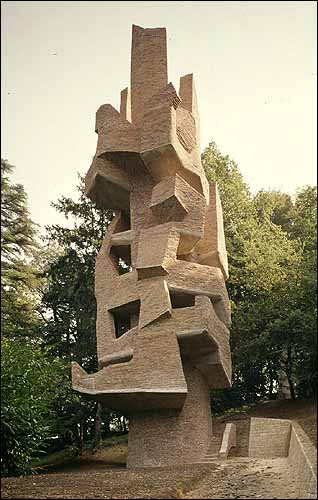ENVIRONMENTAL ART
by Lucien den Arend

my first letterhead in 1969
In my first commission I was
asked to submit a proposal for an enclosed garden
which had not yet been made. In the process of
studying the space, I decided to make a work of art which
would surround you. I was very excited by the idea that this
could be much more than a sculpture around
which one can walk. Regarding an environment as a specific
area, I decided to give a name to art which was the
environment itself - 'environmental sculpture'. The
term 'environmental' was more or less a reaction to
the limited possibilities of sculptors to only make
a sculpture as an object, however large or
consisting of parts, and install it, or them. At the
most it used to be possible to adjust or alter the
area or space in which the sculpture was placed.
In the late sixties of last
century there was little concern for the environment
in terms of wasting natural resources and
irreparably altering our environment (I use the term
here, because we now understand how its meaning has
shifted from only describing our surroundings
towards encompassing the understanding of our
responsibility to respect and preserve our natural
habitat.
In Joop Beljon's book,
Bouwmeesters van morgen
I saw André Bloc's sculpture,
habitable
(inhabitable sculpture). Though both
sculptures belonged to a style of working which were
far from my aspirations, I grasped the idea of
sculpture which one could occupy. I had met Joop Beljon during my studies at California State
University at Long Beach, California.
Long Beach symposium was the first event of its
kind held in the United States. More importantly, it
was a significant experiment in the formal
collaboration of art and technology. Each of the
invited artists (selected from a worldwide list of
distinguished sculptors) was paired with an
industrial sponsor who provided technological
assistance in the form of expertise, assess to
facilities, equipment, and materials. The on-campus
site also provided students with the opportunity to
observe and assist established artists in an
environment that was very different from the usual
classroom activities.
André Bloc was one of the other sculptors who
participated in the Long Beach symposium.

Habitacle (cubicle) no.1 (1962), Meudon,
France 1964).

André Bloc, sculpture-habitacle (cubicle) "La Tour",
1966, Meudon

André Bloc, Sculpture-habitacle (cubicle) #2, Meudon,
France 1964
But the sculpture which struck me most was
Joop Beljon's Homage to Sam Rodia.
During my further studies in Holland I had seen
Etienne Martin's Demeure (dwelling) 3, in the
sculpture garden of the Kröller Müller Museum on the
Dutch Hoge Veluwe;

Etienne Martin's Demeure (dwelling) 3
It is a sculpture consisting of different
elements with a space between them. In that way you
could enter the sculpture and be between its parts.
This, was something new in art. Somehow the
sculpture enclosed its own environment.
I wanted to pursue this way of working, but then
with a total environment in my sculpture, and
decided to call this new development in my work
'environmental sculpture'.
In that time it was as if a new world had opened itself to me.
|




